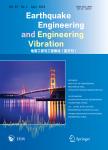Optimum geometry of tuned liquid column-gas damper for control of offshore jacket platform vibrations under seismic excitation
Optimum geometry of tuned liquid column-gas damper for control of offshore jacket platform vibrations under seismic excitation作者机构:R & D Department Sabok Sazane Sarie Engineering Company Center of Excellence for Engineering and Management of Civil InfrastructuresSchool of Civil Engineering Pardis College of EngineeringThe University of TehranIran
出 版 物:《Earthquake Engineering and Engineering Vibration》 (地震工程与工程振动(英文刊))
年 卷 期:2012年第11卷第4期
页 面:579-592页
核心收录:
学科分类:081405[工学-防灾减灾工程及防护工程] 08[工学] 0818[工学-地质资源与地质工程] 0815[工学-水利工程] 0813[工学-建筑学] 0802[工学-机械工程] 0814[工学-土木工程] 0801[工学-力学(可授工学、理学学位)]
基 金:Pardis College of Engineering at the Univ. of Tehran Under Project No.8108020/1/01 Sabok Sazan Sarie Co
主 题:passive control tuned liquid column damper TLCGD offshore platform optimum geometry
摘 要:In this study, the effectiveness of a tuned liquid column-gas damper, TLCGD, on *** of seismic-induced vibrations of steel jacket platforms is evaluated. TLCGD is an interesting choice in the case of jacket platforms because it is possible to use the structural elements as the horizontal column of the TLCGD. The objective here is to find the optimum geometric parameters, namely orientation and configuration of vertical columns, length ratio, and area ratio of the TLCGD, considering nonlinear damping of the TLCGD and water-structure interaction between the jacket platform and sea water. The effects of different characteristics of ground motion such as PGA and frequency content on the optimum geometry are also investigated and it is observed that these features have some influence on the optimum area ratio. Finally it is observed that pulse arrangement of ground acceleration is one of the most important parameters affecting the efficiency of a TLCGD. In other words, it is found that the TLCGD's capability to reduce the RMS responses depends only on the frequency content of the ground acceleration, but its capability to reduce the maximum responses depends on both the frequency content and the pulse arrangement of the ground acceleration.



